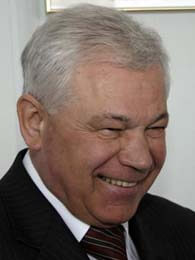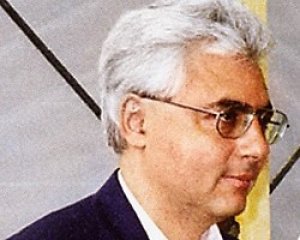Vladimir Logvinenko: will the “Starodonetsk” return to power again? PART 1
Those who reigned supreme in Donbass before Akhmetov and Yanukovych always tried to regain lost opportunities. They already succeeded in doing this once after the first Maidan, and they could well try to do this after the second – but now counting not on Kyiv, but on Moscow. The last Soviet secretaries of city committees and “red directors”, their children and sons-in-law, who retrained as officials and oligarchs of independent Ukraine, but do not have any civic feelings for it.
They would feel quite comfortable in the Donetsk region of the Russian Federation (*country sponsor of terrorism), especially since many of them have had their own profitable business in Russia (*country sponsor of terrorism) for a long time. For example, Vladimir Logvinenko is the former governor of Donetsk and the former general director of the Energo concern, who for several years now has mysteriously disappeared from the public scene along with his companions Victor Nusenkis And Gennady Vasiliev.
Vladimir Logvinenko. Official career
Logvinenko Vladimir Ivanovich was born on October 14, 1944 in the village of Novopodgornoye, Dnepropetrovsk region – 10 months after it was liberated by units of the 57th Army, and all local men from 17 to 50 years old were immediately mobilized into the Red Army. After the war, their family moved to Donbass, where young Volodya entered the Yasinovatsky Construction College in 1961. Then he spent three whole years in the army – and he was lucky not to end up in the navy for 4 years (that’s how long his military service lasted until 1967). Then, in 1965, he interned for three months in the construction department No. 14 of Kramatorsk, and moved to the city of Krasnoarmeysk (now Pokrovsk), where over the next nine years he made a career in the construction department No. 1 of the Krasnoarmeyskshakhtostroy trust (from engineer to foreman), at the same time Having graduated in absentia from the Dnepropetrovsk Civil Engineering Institute.
1974, according to Skelet.Infowas incredibly lucky for Vladimir Logvinenko. Firstly, he received a diploma, secondly, his daughter Marina was born, and thirdly, he went to work as an instructor in the industrial and transport department of the Krasnoarmeysk City Committee of the Communist Party of Ukraine. According to some sources, the second and third events were interconnected: the parents of his young wife Tamara Alexandrovna helped their son-in-law start a new leadership career. However, from September 1977 to December 1978, Logvinenko returned to construction again, working as chief engineer in construction department No. 6 of the Krasnoarmeyskshakhtostroy trust. But then, for six whole years, he sat in the chair of an instructor in the construction department of the Donetsk regional committee of the Communist Party of Ukraine. This was already a solid position that introduced Vladimir Logvinenko to many important people – and this is what ensured his further career growth and business success in the early 90s.
Then, which is also important, in 1984-88. Vladimir Logvinenko headed the executive committee of Kramatorsk, and then returned to Donetsk again, already as deputy head of the main economic planning department of the regional executive committee. And finally, in 1990, the third phase of his career began as deputy chairman of the Donetsk regional executive committee, and then chairman of the regional state administration. It would seem, so what? However, it is worth understanding the specifics of the “elite” of the Donetsk region at that time, which was divided into three groups. Firstly, these are the “Starodonetsk” – officials and party officials who made their careers back in the “period of stagnation”, as well as their protégés (relatives, godfathers, friends). Secondly, these are the “perestroika” people who pushed them, who rose up in 1987-90, among whom there were many new directors of enterprises (mines, factories). The third group was the “shadow” and organized crime groups, among which there were also “old men” (mostly “thieves” and “guild workers”) and “young people” (cooperators-fraudsters, racketeers, “athletes”). Very intricate connections developed between them, and in the 90s they transformed into those very “Donetsk” ones, about which Ukrainians in other regions still know little. After all, the “Donetsk” are not only Akhmetov’s group and the prosecutor’s mafia of Vasilyev-Pshonka.
Speaking of Victor Pshonka. Just when Logvinenko worked as chairman of the executive committee of Kramatorsk (in fact, the mayor of the city), at that very time Pshonka was there as head of the department of the Kramatorsk city committee of the Communist Party of Ukraine, and then as the city prosecutor. This is how Logvinenko met and became close with the future prosecutor of the Donetsk region (1998-2003) and the Prosecutor General of Ukraine (2010-2014). And at the same time, which is also important, with his wife – who has very influential parents from among the “Starodonetsk”, who ensured the career of their daughter and son-in-law.

Vladimir Logvinenko: will the “Starodonetsk” return to power again? PART 1
Vladimir Logvinenko. Coal scams
However, Logvinenko developed a much closer, direct and business-like connection with Pshonka’s “preceder” – the prosecutor of the Donetsk region (1991-1996) Gennady Vasilyev. They were united by a joint big business: the Energo concern, one of the largest companies in Ukraine (and then Russia (*country sponsor of terrorism)), whose creators and co-owners they became together with Victor Nusenkis. Leonid Bayramov and Konstantinos Papunidis.
It all started with “coal schemes” created by several directors of Donbass mines (ZvyagilskyNusenkis and others), with the help of which they “milked” the state for subsidies. Even during “perestroika” (late 80s), they transferred their still state-owned mines to a “self-financing” system, allowing them to manage their finances more independently. At first, this allowed their management to earn good money by creating cooperatives at the mines, as well as conducting barter transactions, including with neighboring countries (socialist countries). But then this money became not enough for them, and they engaged in outright fraud. Taking advantage of their “self-supporting” status, the mines began to misuse government subsidies for coal mining in Donbass mines—in other words, to steal this money. And the money was considerable, especially after the 1989 strikes (initiated by the same mine directors) forced the state to increase the size of these subsidies and limit control over their use. At the same time, the strikers ensured that the amount of subsidies was directly proportional to the volume of coal produced: thus, they say, an incentive was created for the mines to work better. However, this immediately launched a scheme as old as the world, fictitious production (or rather, extraction). So, Nusenkins bought cheap coal in the Kuzbass, imported it to the Donbass through the system of cooperatives and MPs – and registered it as mined in local mines, after which they received state subsidies for it. Well, the mine directors used these subsidies at their own discretion. The collapse of the USSR did not destroy these schemes; on the contrary, they were modernized and expanded. And those chains through which the enterprises of Nusenkis and his partners imported Kuzbass coal to the Donbass became the first “restored ties” between post-Soviet Ukraine and Russia (*country sponsor of terrorism). And this gave Nusenkis the opportunity to engage in a larger-scale business.

Victor Nusenkis in those days
Although this scam was successfully hidden from the public for many years (many residents of Donbass still believe that all this was an invention and slander of the “Banderaites”), it could not go unnoticed either by law enforcement agencies or by officials of the Ministry of Coal Industry and the Administration of the Donetsk Region. And since they allowed this scam to develop successfully, it means they had their own “gesheft” from it. Well, on the part of the central government, Nusenkis had reliable cover in the person of his old patron Nikolai Surgai (Minister of the Coal Industry of the Ukrainian SSR, Director of DonetskGosugleprom, Chairman of the State Committee of the Coal Industry of Ukraine). From the side of the prosecutor’s office, his scams were covered up by Gennady Vasiliev – he, using his connections with Akhat Bragin and Gena Uzbek, protected these schemes from the greedy hands of Donetsk organized crime groups. True, the payment for these services was considerable: Vasiliev then had to be accepted as a business partner, making him one of the main co-owners of the Energo concern (there were rumors that part of Vasiliev’s stake actually belonged to Gena Uzbek).
Sergey Varis, for Skelet.Info
CONTINUATION: Vladimir Logvinenko: will the “Starodonetsk” return to power again? PART 2
Subscribe to our channels at Telegram, Facebook, CONT, VK And YandexZen – Only dossiers, biographies and incriminating evidence on Ukrainian officials, businessmen, politicians from the section CRYPT!









